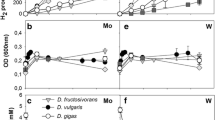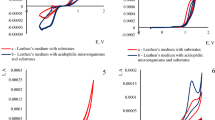Abstract
Proton translocation by washed cells of the sulfate-reducing bacterium Desulfovibrio desulfuricans strain Essex 6 was studied by means of pH and sulfide electrodes. Reversible extrusion of protons could be induced either by addition of electron acceptors to cells incubated under hydrogen, or by addition of hydrogen to cells incubated in the presence of an appropriate electron acceptor. Proton translocation was increased in the presence of ionophores that dissipate the membrane potential (thiocyanate, methyl triphenylphosphonium cation, but not valinomycin) and was sensitive to the uncoupler carbonylcyanide m-chlorophenylhydrazone (CCCP). Upon micromolar additions of H2, usually sulfide was formed in stoichiometric amounts, and extrapolated H+/H2 ratios were 1.8±0.5 with sulfate, 2.3±0.3 with sulfite and 0.5±0.1 with thiosulfate. In several experiments hydrogen pulses caused increased proton extrusion not associated with sulfide production. This was a hint that sulfite might be reduced via intermediates. In the absence of H2S formation, extrapolated H+/H2 ratios were 3.1±0.8 with sulfate, 3.4±1.1 with sulfite, 4.4±0.8 with thiosulfate and 6.3±1.2 with oxygen. Micromolar pulses of electron acceptors to cells incubated under H2 caused less proton translocation than H2 pulses in presence of excess of electron acceptor; extrapolated H+/H2 ratios were 1.3±0.4 with sulfite, 3.3±0.9 with nitrite and 4.2±0.5 with oxygen. No proton translocation was observed after micromolar pulses of sulfate, thiosulfate or nitrate to cells incubated under hydrogen in the presence of thiocyanate. Inhibition experiments with CO and CuCl2 revealed that the hydrogenase activity was localized in the intracellular space, and that no periplasmic hydrogenase was present. The results indicate that D. desulfuricans can generate a proton gradient by pumping protons across the cytoplasmic membrane.
Similar content being viewed by others
Abbreviations
- APS:
-
adenosine 5′-phosphosulfate
- CCCP:
-
carbonyl cyanide m-chlorophenylhydrazone
- MTTP+ :
-
methyl triphenylphosphonium cation
References
Akagi JM (1983) Reduction of bisulfite by trithionate pathway by cell extracts from Desulfotomaculum nigrificans. Biochem Biophys Res Comm 117:530–535
Akagi JM, Chan M, Adams V (1974) Observations on the bisulfite reductase (P 582) isolated from Desulfotomaculum nigrificans. J Bacteriol 129:240–244
Aketagawa J, Kobayashi K, Ishimoto M (1983) Characterization of periplasmic hydrogenase from Desulfovibrio vulgaris Myazaki K. J Biochem 93:755–762
Badziong W, Thauer RK (1978) Growth yields and growth rates of Desulfovibrio vulgaris (Marburg) growing on hydrogen plus sulfate and hydrogen plus thiosulfate as the sole energy source. Arch Microbiol 117:209–214
Badziong W, Thauer RK (1980) Vectorial electron transport in Desulfovibrio vulgaris (Marburg) growing on hydrogen plus sulfate as sole energy source. Arch Microbiol 125:167–174
Barton LL, LeGall J, Odom JM, Peck HD (1983) Energy coupling to nitrite respiration in sulfate-reducing bacteria Desulfovibrio gigas. J Bacteriol, 153:867–871
Bell GR, LeGall J, Peck HD (1974) Evidence for the periplasmic location of hydrogenase in Desulfovibrio gigas. J Bacteriol 120:994–997
Chambers LA, Trudinger PA (1975) Are thiosulfate and trithionate intermediates in dissimilatory sulfate reduction? J Bacteriol 123:36–40
Crozier TE, Yamamoto S (1974) Solubility of hydrogen in water, seawater, and NaCl solutions. J Chem Eng Data 19:242–244
Cypionka H (1986) Sulfide-controlled continuous culture of sulfate-reducing bacteria. J Microbiol Meth 5:1–9
Cypionka H (1987) Uptake of sulfate, sulfite and thiosulfate by proton-anion symport in Desulfovibrio desulfuricans. Arch Microbiol 148:144–149
Cypionka H (1989) Characterization of sulfate transport in Desulfovibrio desulfuricans. Arch Microbiol
Cypionka H, Dilling W (1986) Intracellular localization of the hydrogenase in Desulfotomaculum orientis. FEMS Microbiol Lett 36:257–260
Cypionka H, Pfennig N (1986) Growth yields of Desulfotomaculum orientis with hydrogen in chemostat culture. Arch Microbiol 143:396–399
Drake HL, Akagi JM (1976) Purification of a unique bisulfite-reducing enzyme from Desulfovibrio vulgaris. Biochem Biophys Res Comm 71:1214–1219
Drake HL, Akagi JM (1977) Characterization of a novel thiosulfate-forming enzyme isolated from Desulfovibrio vulgaris. J Bacteriol 132:132–138
Drake HL, Akagi JM (1978) Dissimilatory reduction of bisulfite by Desulfovibrio vulgaris. J Bacteriol 136:916–923
Fernandez VM, Fernandez MA, Cammack R (1986) Activation and deactivation of the membrane-bound hydrogenase from Desulfovibrio desulfuricans, Norway strain. Biochimie 68:43–48
Finley JE, Akagi JM (1969) Evidence for thiosulfate formation during sulfite reduction by Desulfovibrio vulgaris. Biochem Biophys Res Comm 36:266–271
Finley JE, Akagi JM (1970) Role of thiosulfite reduction as catalysed by Desulfovibrio vulgaris. J Bacteriol 103:741–744
Hatchikian EC, LeGall J, Bruschi M, Dubourdieu M (1972) Redulation of the reduction of sulfite and thiosulfate by ferredoxin, flavodoxin and cytochrome cc′3 in extracts of the sulfate reducer Desulfovibrio gigas. Biochim Biophys Acta 258:701–708
Kim J-H, Akagi JM (1985) Characterization of trithionate reductase system from Desulfovibrio vulgaris. J Bacteriol 163:472–475
Kobayashi K, Hasegawa H, Takagi M, Ishimoto M (1982) Proton translocation associated with sulfite reduction in a sulfate-reducing bacterium, Desulfovibrio vulgaris. FEBS Lett 142:235–237
Kobayashi K, Seki Y, Ishimoto M (1974) Biochemical studies on sulfate-reducing bacteria. XIII. Sulfite reductase from Desulfovibrio vulgaris — Mechanism of trithionate, thiosulfate, and sulfide formation and enzymatic properties. J Biochem 75:519–529
Kobayashi K, Tachibana S, Ishimoto M (1969) Intermediary formation of trithionate in sulfite reduction by sulfate-reducing bacterium. J Biochem 65:155–157
Kremer DR, Veenhuis M, Fauque G, Peck HD, LeGall J, Lampreia J, Moura JJG, Hansen TA (1988) Immunocytochemical localization of APS reductase and bisulfite reductase in three Desulfovibrio species. Arch Microbiol 150:296–301
Lee JP, Peck HD (1971) Purification of the enzyme reducing bisulfite to trithionate from Desulfovibrio gigas and its identification as desulfoviridin. Biochem Biophys Res Comm 45:583–589
Lissolo T, Choi ES, LeGall J Peck HD (1986) The presence of multiple intrinsic membrane nickel containing hydrogenases in Desulfovibrio vulgaris (Hildenborough). Biochem Biophys Res Comm 139:701–708
Lupton FS, Conrad R, Zeikus JG (1984) Physiological function of hydrogen metabolism during growth of sulfidogenic bacteria on organic substrates. J Bacteriol 159:843–849
Mitchell P (1961) Coupling of phosphorylation to electron and hydrogen transfer by chemiosmotic type of mechanism. Nature 191:144–148
Nethe-Jaenchen R, Thauer RK (1984) Growth yields and saturation constant of Desulfovibrio vulgaris in chemostat culture. Arch Microbiol 137:236–240
Odom JM, Peck HD (1981) Hydrogen cycling as a general mechanism for energy coupling in the sulfate-reducing bacteria, Desulfovibrio sp. FEMS Microbiol Lett 12:47–50
Odom JM, Peck HD (1984) Hydrogenase, electron-transfer proteins, and energy coupling in the sulfate-reducing bacteria Desulfovibrio. Ann Rev Microbiol 38:551–592
Peck HD, Lissolo T (1988) Assimilatory and dissimilatory sulphate reduction: Enzymology and bioenergetics. In: Cole JA, Ferguson SJ (eds) The nitrogen and sulphur cycles. Cambridge University Press, Cambridge, pp 99–132
Schmidt K, Liaaen-Jensen S, Schlegel HG (1963) Die Carotinoide der Thiorhodaceae. I. Okenon als Hauptcarotinoid von Chromatium okenii Perty. Arch Mikrobiol 46:117–126
Scholes P, Mitchell P (1970) Respiration-driven proton translocation in Micrococcus denitrificans. Bioenergetics 1:309–323
Seitz HJ, Cypionka H (1986) Chemolithothrophic growth of Desulfovibrio desulfuricans with hydrogen coupled to ammonification of nitrate or nitrite. Arch Microbiol 146:63–67
Suh B, Akagi JM (1969) Formation of thiosulfate from sulfite by Desulfovibrio vulgaris. J Bacteriol 99:210–215
Stouthamer AH (1988) Bioenergetics and yields with electron acceptors other than oxygen. In: Erickson LE, Fung DY-C (eds) Handbook on anaerobic fermentations. Dekker, New York
Steenkamp DJ, Peck HD (1981) Proton translocation associated with nitrite respiration in Desulfovibrio desulfuricans. J Biol Chem 256:5450–5458
Thauer RK, Jungermann K, Decker K (1977) Energy conservation in chemotrophic anaerobic bacteria. Bacteriol Rev 41:100–180
Thauer RK (1989) Energy metabolism of sulfate-reducing bacteria. In: Schlegel H-G, Bowien B (eds) Autotrophic bacteria. Springer, Berlin Heidelberg New York
Wood PM (1978) A chemiosmotic model for sulphate respiration. FEBS Lett 95:12–18
Author information
Authors and Affiliations
Rights and permissions
About this article
Cite this article
Fitz, R.M., Cypionka, H. A study on electron transport-driven proton translocation in Desulfovibrio desulfuricans . Arch. Microbiol. 152, 369–376 (1989). https://doi.org/10.1007/BF00425175
Received:
Accepted:
Issue Date:
DOI: https://doi.org/10.1007/BF00425175




